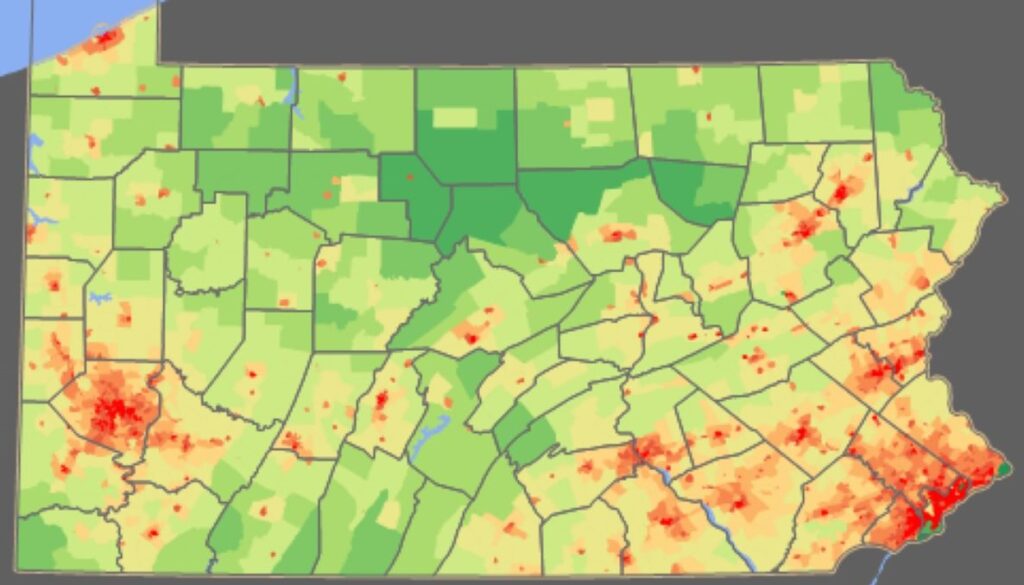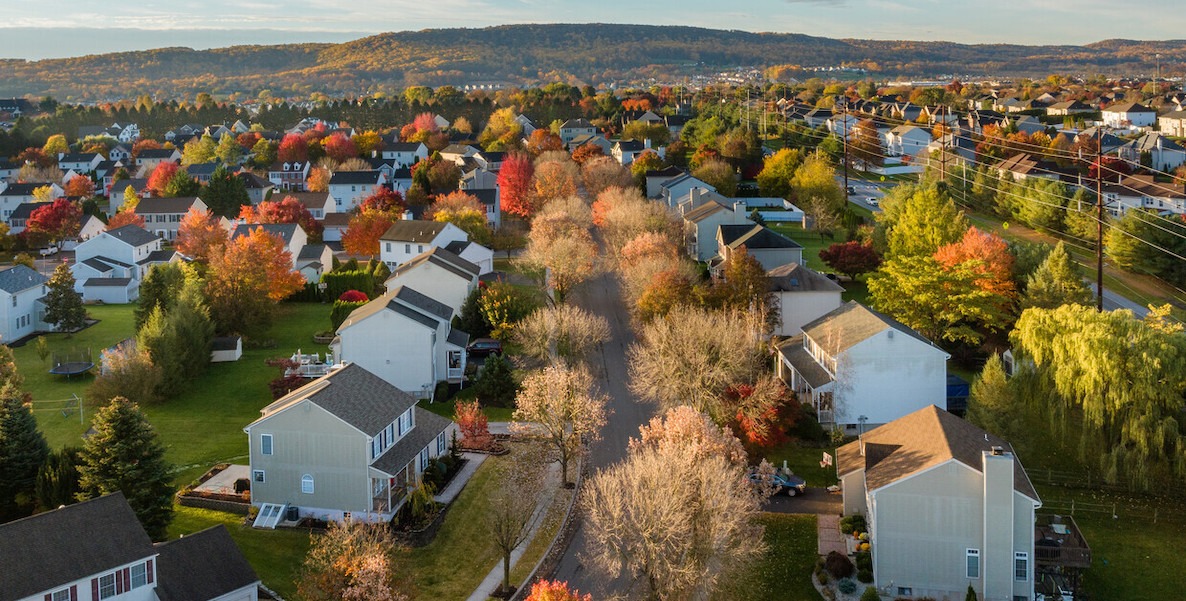For ten presidential election cycles, pundits have employed the same shopworn quote when describing Pennsylvania: “Philadelphia and Pittsburgh, with Alabama in the middle.” The expression was coined in the state’s 1986 gubernatorial campaign by Democratic political strategist James Carville, whose success in that race helped propel a storied career. Ever since, PA’s “Alabama” has dictated perceptions of the electorate outside its two major cities.
Carville recently defended the phrase, calling it “a graphic way … [to] get your point across.” That may be, but the description misrepresents Pennsylvania’s vast middle, which not only forms the heart of the state’s Trump-era political realignment but also makes this most pivotal of swing states fiendishly difficult to analyze. The complexities of the region also explain why polls persistently show a neck-and-neck race between Donald Trump and Kamala Harris in PA.
Even today, the Keystone State’s rural counties are home to what one historian described as “the most conservative people in America.” This culture, enveloping south-central PA and the Lehigh Valley, was documented by John Updike, the Berks County native and German Lutheran Democrat whose Rabbit tetralogy and short stories captured the region’s conservative sensibilities.

The region is also home to small cities shaped by their industrial past, ethnic and religious diversity, and role in the American labor movement. And then there’s the “Pennsylvania protectorate” — the northeast’s anthracite coal region, chronicled by Schuylkill County prodigy John O’Hara, an Irish Catholic Republican whose stories examined the local Protestant aristocracy and its tensions with Catholic laborers and strivers.
Influenced by Carville’s “Alabama” characterization, political pundits tend to lump these distinct “middle” regions together — especially south-central Pennsylvania, the state’s northeast, and the Lehigh Valley, which have seen profound demographic and economic changes in recent years. Pennsylvania’s “middle” has come a long way from being a land of horse-and-buggies, corn fields and chocolate, depressed coal and steel towns, and churches and bars on every street corner.
Today, these regions constitute the East Coast’s inland empire, its economy fueled by health care, logistics, manufacturing, and the life sciences. Over the past eight years, warehouses and hospitals have sprouted up in empty fields. Suburban developments have drawn in young professionals and remote workers. Latinos, with familial links to metro New York, now make up the plurality or even majority in some cities and towns. These regional dynamics are the key to understanding Pennsylvania, and to determining whether Trump or Harris wins here — and perhaps also takes the White House.
In the case of the Lehigh Valley, which includes the city of Allentown and Northampton County — an Obama-to-Trump-to-Biden pivot county — out-of-staters conjure images of shuttered steel mills and factories associated with Billy Joel lyrics. That’s another outdated image: today, the region’s economic output surpasses that of two states (Vermont and Wyoming), and it tops national rankings for economic development projects. Manufacturers, including in the life sciences, have expanded industrial space around the valley’s three cities. The region has also become a supply-chain empire. The Covid era intensified the already-rising demand for e-commerce, and the Valley’s interstate highway network, in addition to its proximity to New York, resulted in a dramatic increase in warehousing projects.
Purple politics of Pennsylvania
Demographic changes and economic growth have made the region less predictable in electoral politics. Northampton County, long considered PA’s bellwether, has led the state in Generation Z population growth. Easton, the Northampton County seat, attracts New York expatriates, while Latinos form a majority in Allentown. Politically, the region has turned broadly purple, with blue and red pockets in unforeseen spots.
For example, Allentown suburb Upper Macungie Township, not long ago a locale of fields and sleepy Pennsylvania Dutch towns, has become a sprawling expanse of new housing developments, warehouses, and hospitals. In 2020, its precincts shifted toward the Democrats by up to 10 percentage points compared with 2016. The 2024 presidential election will test the red shift in Pennsylvania’s Latino-majority neighborhoods, including in Allentown and Bethlehem’s South Side. For instance, in Allentown’s 6th Ward — a neighborhood of Hispanic and Arab residents once known as Little Syria — Trump improved his performance from 2016 to 2020 by up to 20 percentage points.
On Election Day, the state’s political realignment will be tested not in Philadelphia or Pittsburgh but in regions that represent the most demographically complex expanse among the swing states.
A pronounced shift toward the GOP has also occurred in northeastern PA, home to cities like Scranton and Hazleton that once fueled America’s industrial rise with anthracite coal. “They didn’t film The Deer Hunter here for nothing,” Carville says. Even today, out-of-staters view the region through the lens of that 1978 film about Vietnam-era Slavic Americans in a working-class PA town. But over the past 20 years, northeastern PA — especially its largest county, the Obama-to-Trump Luzerne — experienced one of the nation’s fastest rates of demographic change. Latinos are now a majority in communities such as Hazleton, and the links to Italy and Eastern Europe that once characterized old coal-region neighborhoods are increasingly giving way to ties to the Dominican Republic and metro New York.
The warehousing and manufacturing boom that emerged in the Lehigh Valley has since expanded to a span of Interstate 81 from Schuylkill County to Hazleton, where proposed warehousing projects are transforming the city’s landscape. The regional growth of industrial parks has increased the Latino presence not only in Hazleton but also in communities like Shenandoah and McAdoo, towns that served as the birthplace of the Ukrainian Catholic Church in America. These days, around the Hazleton area, Latino congregations meet in offices, homes, and old ethnic Catholic parishes.
Northeastern PA was long associated with Catholicism and the Democratic Party, but the church has lost a great deal of its strength, and the party is at its weakest in memory. As of this fall, registered Republicans outnumber Democrats in Luzerne, and the region’s lifelong Catholic Democrats are shifting toward Trump. Democrats narrowly won Hazleton in 2012, but today, it’s double-digit Trump territory. Meantime, Scranton’s heavily Latino South Side is home to Lackawanna County’s GOP headquarters, just off the President Biden Expressway. The headquarters is in one of nine Scranton precincts that shifted to the Republicans in 2020 despite Biden’s being a hometown presidential candidate. And in Schuylkill County, Pennsylvania’s first Republican Hispanic mayor, a New York City native, took office earlier this year.
Meantime, a suburban boom just south of the Blue Mountain ridge is disrupting Republican dominance of south-central PA’s Cumberland and Lebanon Valleys. Outsiders still consider this Amish country, a land unchanged from the one depicted in the 1985 film Witness. But in recent years, this region, especially the Harrisburg-Hershey area, has become the fastest-growing area of PA.
A healthcare boom, with expanding medical systems and new hospital construction, has drawn a medical workforce that now resides in sprawling new communities on Harrisburg’s East and West Shore. As in the Lehigh Valley, new warehouses are never far from all this construction, and remote workers are flocking to vibrant areas like Lancaster City and Harrisburg’s Midtown neighborhood. Parts of the region, like Cumberland County’s West Shore, are beginning to resemble the sprawling exurbs that turned northern Virginia blue in the 2000s. All this growth is leading to a Democratic ascendance in communities that were a GOP lock as recently as 2016.
Take Hershey, the confectionary empire founded by a Pennsylvania Dutch Republican and current headquarters of Penn State Health and its College of Medicine. During Trump’s presidency, voter registration surged dramatically here, with Democrats prevailing in local elections and Biden carrying the community in 2020. This blue shift has also occurred in Harrisburg’s West Shore in communities like Camp Hill, an upscale suburb. The Harris-Walz campaign has targeted south-central areas like Lancaster County, the historical heart of the GOP in Pennsylvania, last carried by Lyndon Johnson in 1964. Though the area itself still trends Republican, Democrats are relying on there being just enough suburban professionals to push them over the edge in PA.
These regions will dictate the electoral outcome in PA. For Republicans, success will depend on winning back enough suburban professionals in places like Hershey, which favored Trump in 2016, and courting Trump-to-Biden voters, much as the former president relied on working-class Obama voters in 2016. For Democrats, high voting margins among suburbanites would have to expand into growing residential communities — often filled with upper-middle-class New York transplants — in northeastern PA’s Schuylkill and Luzerne Counties, and the Poconos.
The GOP faces a challenge in this region on healthcare, which looms large among suburban professionals but also for aging working-class residents dealing with chronic health issues and medical debt. This is the case in Luzerne, where the health system Geisinger recently announced a $900 million expansion. “We’re taking care of more people than ever before,” one Geisinger official noted in a press release, “and those we treat in the emergency room are sicker than they’ve ever been.”
Many working-class voters, including in Hazleton and Reading, no longer view the Democratic Party as representing their economic interests. This follows years of intensifying suspicion of the party in regions like the northeast and parts of the Lehigh Valley. In Luzerne, Democrats are now seen as the party of the technocratic class that supported NAFTA and globalization. In the 2000s, both parties were regarded with suspicion on issues like illegal immigration and the Iraq War. Trump tapped into this frustration. In the Covid era, working-class Latino and White residents have endured rising prices as both consumers and business owners. Democrats’ trumpeting of positive economic data does not align with the financial realities of voters in these areas.
On Election Day, the state’s political realignment will be tested not in Philadelphia or Pittsburgh but in regions that represent the most demographically complex expanse among the swing states. The 2024 election will measure just how blue the suburbs are turning around south-central cities Harrisburg and Lancaster, while Republicans will rely not only on historic margins among Latino voters but also on working-class residents who still voted Democratic as recently as a decade ago.
Whatever happens on November 5, one thing is certain: This is not “Alabama.”
Charles F. McElwee is the founding editor of RealClearPennsylvania. He is a contributing writer at POLITICO Magazine. Follow him on X at @CFMcElwee. This piece originally appeared in City Journal.
![]() MORE ON THE 2024 ELECTION FROM THE CITIZEN
MORE ON THE 2024 ELECTION FROM THE CITIZEN





